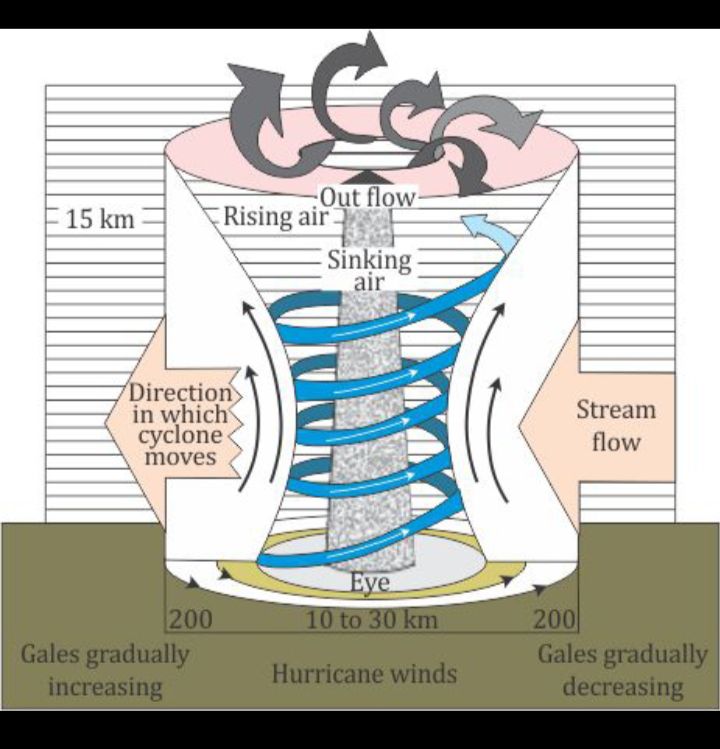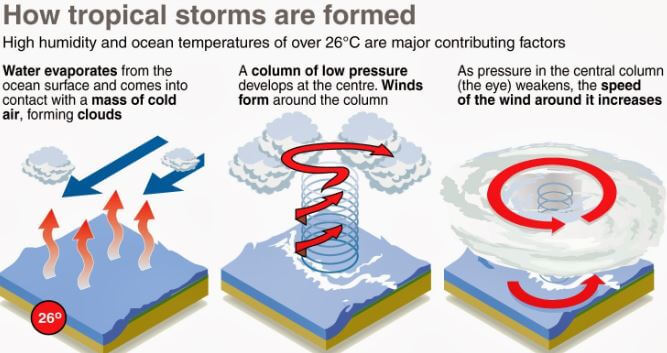CYCLONE BIPARJOY
1. Context
A cyclonic storm, named Biparjoy, has developed in the Arabian Sea. On Thursday (June 8 2023) afternoon, it was stationed about 850 km west of Goa and 900 km southwest of Mumbai. The cyclone is predicted to gain in strength over the next three days and develop into a very severe cyclonic storm by June 13 2023.

2. About Cyclone Biparjoy
- According toan Indian Meteorological Department (IMD) advisory on Thursday (June 8), the cyclone would result in squally weather with wind speeds reaching 35-45 kmph along the coastline of Karnataka, Goa and Maharashtra
- Cyclone is expected to keep the monsoon a little subdued. The IMD announced the onset of the monsoon on the Kerala coast
- According to IMD monsoon could progress to some more parts of central Arabian Sea, remaining parts of Kerala, some parts of Tamil Nadu, some parts of Karnataka and some parts of the northeastern states
- ‘Biparjoy’ was suggested by Bangladesh and the word means ‘disaster’ or ‘calamity’ in Bengali
- The naming of cyclones is done by countries on a rotational basis, following certain existing guidelines
3. Meteorological Centres
- Worldwide, there are six regional specialised meteorological centres (RSMCs) and five regional Tropical Cyclone Warning Centres (TCWCs) mandated for issuing advisories and naming of tropical cyclones
- IMD is one of the six RSMCs to provide tropical cyclone and storm surge advisories to 13 member countries under the WMO/Economic and Social Commission for Asia-Pacific (ESCAP) Panel including Bangladesh, India, Iran, Maldives, Myanmar, Oman, Pakistan, Qatar, Saudi Arabia, Sri Lanka, Thailand, United Arab Emirates and Yemen.
- RSMC, New Delhi is also mandated to name the Tropical Cyclones developing over the north Indian Ocean (NIO), including the Bay of Bengal (BoB) and the Arabian Sea (AS)
- So, the tropical cyclones forming over different Ocean basins are named by the concerned RSMCs & TCWCs
4. Names of Cyclones
The WMO/ESCAP Panel on Tropical Cyclones in 2000 agreed in principle to assign names to the tropical cyclones in these seas
This list contained names proposed by then eight member countries of WMO/ESCAP PTC, viz., Bangladesh, India, Maldives, Myanmar, Oman, Pakistan, Sri Lanka and Thailand
It was expanded to include five more countries in 2018 — Iran, Qatar, Saudi Arabia, United Arab Emirates and Yemen
The list of 169 cyclone names released by IMD in 2020 was provided by these countries — 13 suggestions from each of the 13 countries
Some rules are to be followed while naming cyclones, such as:
- The proposed name should be neutral to (a) politics and political figures (b) religious believes, (c) cultures and (d) gender
- Name should be chosen in such a way that it does not hurt the sentiments of any group of population over the globe
- It should not be very rude and cruel in nature
- It should be short, easy to pronounce and should not be offensive to any member
- The maximum length of the name will be eight letters
After Bangladesh, the next cyclone will be named ‘Tej’ based on India’s suggestion
5. Cyclones in Arabian sea and Bay of bengal
- There are fewer number of cyclones in the Arabian Sea than the Bay of Bengal, but it is not uncommon
- In fact, June is one of the favourable months for the formation of cyclones in the Arabian Sea
- A cyclone is a low-pressure system that forms over warm waters.
- Usually, a high temperature anywhere means the existence of low-pressure air, and a low temperature means high-pressure wind
- In fact, that is one of the main reasons why we see greater number of cyclones in the Bay of Bengal compared to Arabian Sea
- Bay of Bengal is slightly warmer. Because of climate change, the Arabian Sea side is also getting warmer, and as a result, the number of cyclones in the Arabian Sea is showing an increasing trend in the recent trend
6. Cyclone formation
- As air warms over hotter regions, it ascends, leading to low pressure at the surface it is covering
- When air cools in colder areas it descends, leading to high pressure at the surface
- In a depression or low-pressure situation, the air is rising and blows in an anticlockwise direction around the low in the northern hemisphere and in a clockwise direction in the southern hemisphere
- This is because of the Coriolis effect, a result of the earth’s rotation on its axis.
- As warm air rises and cools, water vapour condenses to form clouds and this can lead to rains
- Weather systems formed over the Bay of Bengal in the peak of summer in May are among the strongest in the North Indian Ocean region
- Warm seas present ripe conditions for the development and strengthening of cyclones and fuel these systems over the water
- Storms intensify and sustain depending on the energy availability through heat load in oceans and moisture
- Historically, the Bay of Bengal has been known for tropical cyclones. But over the years there has been an increase in cyclones forming in the Arabian Sea, as well

|
For Prelims: Cyclones, Formation of Cyclones, IMD
For Mains: 1.What is a tropical cyclone? Discuss the formation of cyclone (250 words)
2. Cyclones are more in Bay of bengal than in Arabian sea. Comment (250 words)
|
Source: indianexpress




